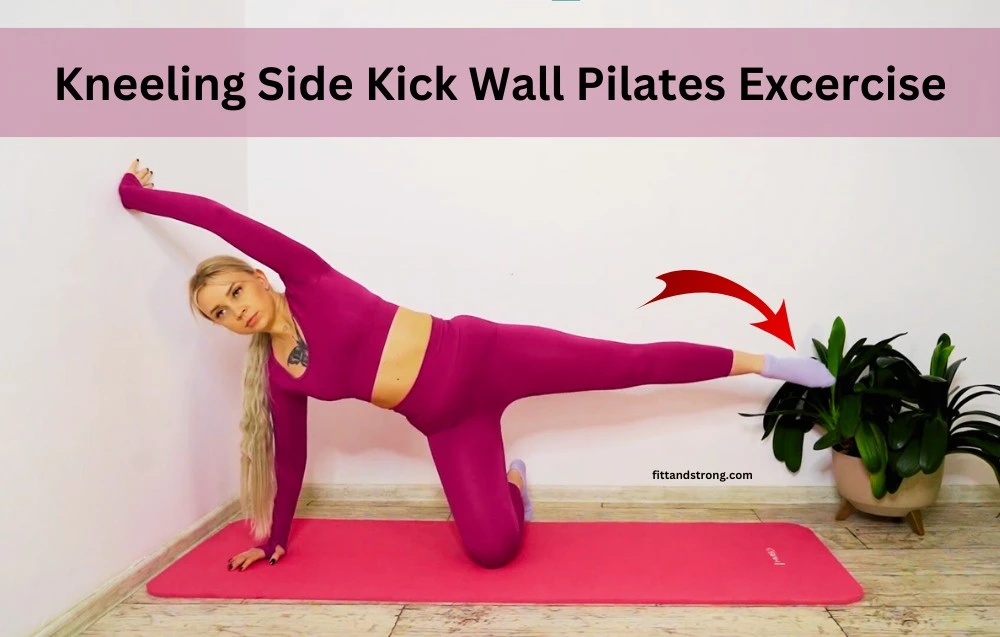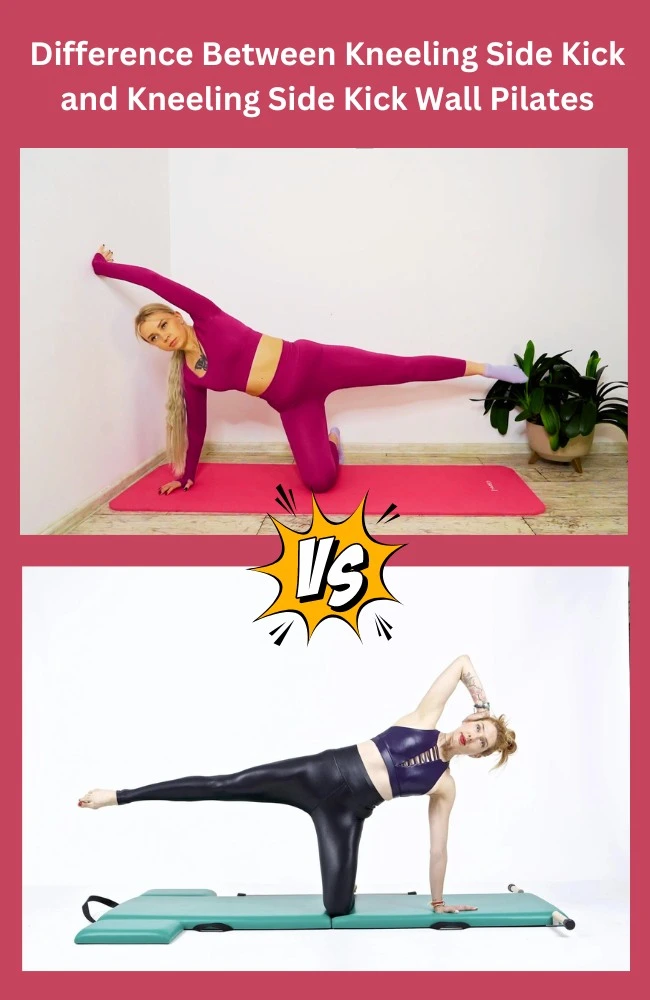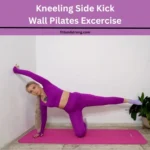To perform the Kneeling Side Kick Wall Pilates Exercise, you need to start by placing your right knee and right palm on the floor. Position your left hand against the wall and align your left leg with your torso. Then, moving only your hips, kick your left leg forward in a straight line with your torso, and then bring it back. Be sure to follow my below given specific instructions carefully to maintain proper form and technique.
If you’re New to Wall Pilates or have never tried the Kneeling Side Kick before, this blog post will guide you on how to perform this exercise safely, minimizing the risk of injury. It’s a great way for beginners to get started without feeling overwhelmed.
And for those of you who are already following a wall Pilates workout, here’s some good news: there are 9 variations and modifications of this exercise that you can apply to make it even more effective. Whether you’re looking to mix things up or adjust the difficulty level, these options can help Enhance your Wall Pilates Routine.
For Seniors who have incorporated Wall Pilates into their routines or anyone recovering from an injury, this low-impact exercise can offer amazing benefits. Let’s dive in and start exploring how you can integrate the Kneeling Side Kick into your exercise regimen to enjoy its many advantages.
What is Kneeling Side Kick Wall Pilates?

The Kneeling Side Kick Wall Pilates is a challenging exercise that demands organization of the shoulder girdle and weight bearing through one arm. It’s part of a series of Mat Pilates Exercises performed in a specific order to progressively build strength and flexibility in key areas of the body.
This exercise specifically requires stability and strength from the upper body, including the head, neck, and shoulder. Initially, you would have Worked Both Arms with movements like leg pull and leg pull front. Now, you focus on maintaining that stability while transferring the support to just one arm.
Hip joint mobility is crucial for this exercise. Without adequate hip mobility, placing your hand on the floor while keeping your thigh vertical can be challenging. Often, people experience a muscle cramp in the hip due to the lack of hip mobility, highlighting the importance of proper preparation and technique to perform this exercise effectively.
Difference Between Kneeling Side Kick and Kneeling Side Kick Wall Pilates

The Kneeling Side Kick and Kneeling Side Kick Wall Pilates are Closely Related Exercises, primarily distinguished by the use of a wall for support in the latter. While the traditional Kneeling Side Kick challenges balance and core strength by requiring the practitioner to lift and lower a leg without external support, the Kneeling Side Kick Wall Pilates involves leaning one hand against a wall.
This adjustment offers additional stability, making it easier to maintain proper alignment and focus on engaging the target muscles effectively. The wall-supported version is particularly Suitable for Beginners or those needing extra stability to safely perform the exercise, enhancing both technique and confidence.
Kneeling Side Kick Wall Pilates: Step-by-Step Detailed Technique
Step 1: Setting Up Your Base
- Begin by kneeling on a Pilates mat with your body in an upright position and your spine in a neutral position.
- Position one hand flat on the mat directly beneath your shoulder for support, and place your other hand behind your head with the elbow pointing outwards.
In setting up your base for the Kneeling Side Kick Wall Pilates, these steps help Engage your Core and stabilize your torso, forming a solid foundation for the exercise. Remember, a good start is half the battle!
Step 2: Aligning the Body
- Extend the leg on the same side as the hand on the mat, stretching it straight out to the side. The leg should be parallel to the ground, and your foot should be flexed.
- Ensure your hips are stacked directly over your kneeling knee to create a straight, strong line from your head to your knee. This alignment is crucial for maintaining balance and ensuring the exercise targets the intended muscle groups effectively.
Step 3: Performing the Side Kick
- Inhale and slowly kick the extended leg forward, keeping the leg straight and maintaining hip alignment without tilting or rotating the pelvis.
- Exhale as you sweep the leg back, extending beyond the body line, but keep the movement controlled and avoid letting your hips sway.
When doing the Kneeling Side Kick, it’s important to control your breathing and movement to keep everything in sync. Just like I learned, paying attention to these details really helps with your form and balance.
Step 4: Maintaining Form and Repetition
- Continue the forward and backward movement for several repetitions, usually 5-10 times per side, depending on your fitness level.
- Focus on keeping your core engaged throughout the exercise to support your spine and prevent any sagging or arching in your lower back.
Step 5: Switching Sides
- After completing the set, gently bring your extended leg back to the kneeling position.
- Switch the positions of your hands and legs to repeat the exercise on the opposite side, ensuring the same careful alignment and controlled movements.
Wrapping up one side, remember to shift smoothly and maintain precision on the other. It’s all about balance and symmetry!
Technique Cues
- As you start the exercise, imagine your body forming an arc from the head to the support knee. Press your hand into the mat.
- Use your shoulder abductors to help lift the upper trunk, while the spinal lateral flexors on the closest side lift the spine.
- Simultaneously, use your Hip abductors to lift the lower side of the pelvis, helping to maintain the form of the arc.
- Keep the elbow straight by using the elbow extensors, while keeping the lower scapula down and reaching toward the mat.
- Focus on maintaining the long line of the raised leg as it swings, using knee extensors to straighten the knee and ankle-foot plantar flexors to point the foot.
Importance of Body Alignment and Proper Form
Maintaining the right body alignment and form isn’t just about getting the most out of the Kneeling Side Kick; it’s crucial for avoiding injuries too Like Wall Sit Challenge. When your body isn’t aligned properly, it puts unnecessary strain on your lower back, shoulders, and neck, which can mess with the exercise’s benefits. Here’s why sticking to good form matters so much:
- Prevents Injuries: By keeping everything in line, you make sure the Exercise works the right muscle groups without putting too much pressure on your joints or spine.
- Increases Effectiveness: Holding the correct posture isolates and strengthens key muscles—like your glutes, hamstrings, and core stabilizers. This focus is what makes Pilates so great for boosting your strength and flexibility.
- Enhances Balance and Coordination: Keeping a controlled, aligned posture during your workout really sharpens your proprioceptive skills. That’s your body’s knack for knowing where it is in space, which is super important for both balance and moving smoothly.
So, when you’re doing Pilates exercises like the Kneeling Side Kick, paying close attention to your technique and form can really up your Pilates game. You’ll notice better strength, balance, and body awareness. Trust me, paying attention to these details makes a world of difference!
Kneeling Side Kick Wall Pilates Muscles Worked
In the kneeling Side kick Wall Pilates, You actively Engage your Core Muscles, Glutes, Hamstrings, Hip Abductors, and Hip Abductors Flexors muscles.You can feel your Core Stabilizing Your body which is crucial for balance and overall strength, which I have observed while maintaining the pose.
The Kneeling Side Kick Wall Pilates is a Unilateral Exercise like Wall Lunges, which means it focuses on one side of your body at a time. In this exercise, one side of your body works while the upper body and the muscles on one side of the lower body help maintain your whole body’s stability.
Working Muscles
- Gluteus medius (primary mover in hip abduction)
- Gluteus minimus (assists in hip abduction)
- Tensor fasciae latae (helps stabilize the pelvis during the movement)
- Sartorius (assists in hip flexion and abduction)
Isometrically Contracted Muscles
- External oblique
- Internal oblique (both obliques stabilize the core during movement)
- Transversus abdominis (stabilizes the abdomen, maintaining posture)
- Quadratus lumborum (stabilizes the pelvis and spine on the working side)
- Erector spinae (including spinalis, longissimus, iliocostalis) (supports the spine isometrically)
- Rectus abdominis (maintains posture and supports the core)
- Lower trapezius (stabilizes the scapula if the arms are used for balance)
- Serratus anterior (stabilizes the scapula)
9 Kneeling Side Kick Wall Pilates Benefits
Certainly! When you engage in the Kneeling Side Kick Wall Pilates Exercise, you can particularly notice its positive impact on your balance and core strength. Incorporating this exercise into my routine has dramatically improved my balance and coordination.
Here’s How You can Feel these Benefits:
- Enhances Core Stability: This exercise significantly strengthens the core muscles, enhancing overall stability and balance.
- Improves Hip Mobility: Regular practice increases the range of motion in the hips, which is beneficial for joint health and flexibility.
- Strengthens the Glutes and Hamstrings: It Targets the posterior muscle groups, crucial for lower body strength.
- Increases Abdominal Control: The exercise requires and builds control over the abdominal muscles, aiding in better posture and core strength.
- Promotes Better Posture: Consistent practice helps in maintaining upright posture and reduces the risk of back pain.
- Improves Balance and Coordination: By challenging one’s balance during the kicks in a Bosu Ball workout, this exercise helps improve overall body coordination.
- Enhances Proprioception: It aids in developing a better sense of body position and movement, which is key for all physical activities.
- Builds Functional Strength: The exercise simulates movements that are common in daily activities, thus enhancing functional fitness.
- Increases Muscle Endurance: Continuous movements and holds increase the endurance levels of the engaged muscles, particularly in the core and lower body.
These benefits make the Kneeling Side Kick Wall Pilates exercise a valuable addition to fitness routines, particularly for those looking to enhance core strength, stability, and overall body awareness.
Variations And Modifications
Let’s talk about shaking up your Pilates routine with some cool tweaks to the classic Kneeling Side Kick Wall Pilates. These variations and modifications are great for keeping your workouts fresh and challenging, no matter your fitness level!
- Extended Leg Variation: Why stick to hip height? Shoot that leg higher up next time. It’s a serious core challenge and really fires up those hip abductors.
- Pulsing Leg Variation: When you lift that leg, try adding a little pulse at the top. It’s like turning up the heat on your glutes and hamstrings – you’ll feel that extra burn!
- Resistance Band Variation: Loop a band around your thighs or ankles for this one. It adds a bit of tension, making your muscles work harder through each kick.
- Weighted Ankle Variation: Strap on some ankle weights. It’s a simple way to ramp up the resistance and make those leg muscles really work.
- Arm Position Variations:
- Hand on Hip: Sometimes, just placing your free hand on your hip helps keep your focus on stabilizing those hips and engaging the core even more.
- Overhead Arm Extension: Or, throw that arm up over your head. It’s a fantastic way to challenge your balance and give your core an extra workout.
- Hand on Hip: Sometimes, just placing your free hand on your hip helps keep your focus on stabilizing those hips and engaging the core even more.
- Wall Support Variation: New to this? No worries. Use a wall for a bit of support while you perfect your form.
- Twisting Variation: Here’s a twist—literally. After you kick, twist your torso toward that lifted leg. It’s great for your obliques and spices up the routine.
- Lower Leg Lift: Change it up by lifting your leg up and down instead of kicking it forward and back. It zeroes in on those hip abductors and adductors.
- No Wall Variation: Feeling confident? Try it without the wall. It’s a real test of balance and core strength and perfect for those who want a challenge.
Each variation targets different areas or focuses on improving specific aspects like balance, strength, or endurance. So, depending on what you’re aiming for in your fitness journey, you might find one of these tweaks perfect for stepping up your game. What do you think? Ready to try one out in your next session?
Conclusion
In summary, the Kneeling Side Kick Wall Pilates offers a comprehensive approach to enhancing core stability, flexibility, and overall fitness. This guide aims to equip you with the knowledge and techniques necessary to confidently integrate this exercise into your routine, ensuring you enjoy all its benefits safely and effectively.





